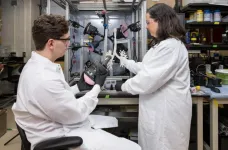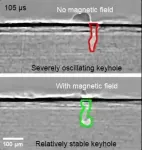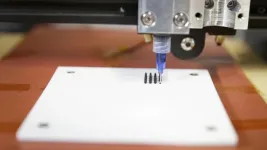(Press-News.org) Respiratory diseases are a challenging problem to treat. Inhalable medicines are a promising solution that depend on the ability to deliver tiny particles known as aerosols to the correct location in the lungs at the correct dosage.
How effectively this works can get complicated, depending on the drug, delivery method and patient. This is because it is difficult to predict just how much medicine gets in and where it goes in the lung. Similar challenges exist when thinking about measuring an inhaled environmental exposure, say to particles of asbestos or a toxin like smoke.
“If it's something environmental and toxic that we're worried about, knowing how far and how deep in the lung it goes is important,” said Catherine Fromen, University of Delaware Centennial Associate Professor for Excellence in Research and Education in the Department of Chemical and Biomolecular Engineering. “If it's designing a better pharmaceutical drug for asthma or a respiratory disease, knowing exactly where the inhaled aerosol lands and how deep the medicine can penetrate will predict how well that works.”
Fromen and two UD alumni have developed an adaptable 3D lung model that can replicate realistic breathing maneuvers and offer personalized evaluation of aerosol therapeutics under various breathing conditions. The researchers have submitted a patent application on the invention through UD’s Office of Economic Innovation and Partnerships (OEIP), the unit responsible for managing intellectual property at UD.
In a paper published in the journal Device, Fromen and her team demonstrate how their new 3D lung model can advance understanding of how inhalable medications behave in the upper airways and deeper areas of the lung. This can provide a broader picture on how to predict the effectiveness of inhalable medications in models and computer simulations for different people or age groups. The researchers detail in the paper how they built the 3D structure and what they’ve learned so far.
Valuable research tool
The purpose of the lung is gas exchange. In practice, the lung is often approximated as the size of a tennis court that is exchanging oxygen and carbon dioxide with the bloodstream in our bodies. This is a huge surface area, and that function is critical — if your lungs go down, you're in trouble.
Fromen described this branching lung architecture like a tree that starts with a trunk and branches out into smaller and smaller limbs, ranging in size from a few centimeters in the trachea to about 100 microns (roughly the combined width of two hairs on your head) in the lung’s farthest regions. These branches create a complex network that filters aerosols as they travel through the lung. Just as tree branches end in leaves, the lung’s branches culminate in delicate, leaf-like structures called alveoli, where gases are exchanged.
“Those alveoli in the deeper airways make the surface area that provides this necessary gas exchange, so you don't want environmental things getting in there where they can damage these sensitive, finer structures,” said Fromen, who has a joint appointment in biomedical engineering.
Mimicking the complex structure and function of the lung in a lab setting is inherently challenging. The UD-developed 3D lung model is unique in several ways. First, the model breathes in the same cyclic motion as an actual lung. That’s key, Fromen said. The model also contains lattice structures to represent the entire volume and surface area of a lung. These lattices, made possible through 3D printing, are a critical innovation, enabling precise design to mimic the lung's filtering processes without needing to recreate its full biological complexity.
“There's nothing currently out there that has both of these features,” she explained. “This means that we can look at the entire dosage of an inhaled medicine. We can look at exposure over time, and we can capture what happens when you inhale the medication and where the medicine deposits, as well as what gets exhaled as you breathe.”
The testing process
Testing how far an aerosol or environmental particle travels inside the 3D lung model is a multi-step process. The exposure of the model to the aerosol only takes about five minutes, but the analysis is time-consuming. The researchers add fluorescent molecules to the solution being tested to track where the particles deposit inside the model’s 150 different parts.
“We wash each part and rinse away everything that deposits. The fluorescence is just a molecule in the solution. When it deposits, we know the concentration of that, so, when we rinse it out, we can measure how much fluorescence was recovered,” Fromen said.
This data allows them to create a heat map of where the aerosols deposit throughout the lung model’s airways, which then can be validated against benchmarked clinical data for where such aerosols would be expected to go in a human under similar conditions.
The team’s current model matches a healthy person under sitting/breathing conditions for a single aerosol size, but Fromen’s team is working to ensure the model is versatile across a much broader range of conditions.
“An asthma attack, exercise, cystic fibrosis, chronic obstructive pulmonary disorder (COPD) — all those things are going to really affect where aerosols deposit. We want to make sure our model can capture those differences,” Fromen said.
The ability to look at specific disease features, say, narrowing of the airways or accumulation of mucus, could one day contribute to more personalized care. For example, perhaps a patient might need longer doses of medicine because the medication is not getting saturated in the body site, or possibly they need a redesigned patient inhaler, so it targets a specific region. This is currently difficult to implement, but the UD-developed model provides a baseline tool for asking those questions.
“This is important because, right now, inhaled pharmaceutics are designed with a one-size-fits-all approach. But someone who has severe COPD, for example, is going to breathe very differently and have a very different lung structure than someone who is healthy,” Fromen said.
Additionally, many inhaled medicines fail clinical trials for unknown reasons. When it doesn't work, researchers wonder, is it the molecule that isn’t effective, was the formulation flawed? Or did the molecule fail to accumulate at a certain level at its target in the lungs?
According to Fromen, clinical trials typically focus on whether a medication results in measurable improvement in a disease, while the UD-developed tool can provide deeper insights. It can determine whether the aerosol got where it needed to go in the first place, and in the right amount, potentially saving time and effort in formulation development and reducing setbacks during clinical trials.
The researchers shared their design and methods in an open-source format, in hopes others will adopt the UD-developed technique.
“Making it accessible to other researchers opens the door for impactful collaborations,” Fromen said. “Clinicians can provide priority patient profiles for us to model, while pharmaceutical developers could integrate the model into their workflows to optimize treatments for specific respiratory conditions.”
Beyond applications in pharmaceutical development, the UD-developed model is also proving valuable in other fields. In a newly funded project with the Army Research Lab, in partnership with a group at Aberdeen Proving Ground, Fromen is using the UD-developed model to help toxicology researchers understand environmental exposures — not only how far things get in, but how much gets in over a given time span and how much is depositing in what regions of the lung, and what the impact is, positive or negative.
END
3D lung model raises the bar for research
Adaptable model can replicate realistic breathing maneuvers and offer personalized evaluation of aerosol therapeutics under various breathing conditions
2025-02-20
ELSE PRESS RELEASES FROM THIS DATE:
Lehigh Engineering faculty named Senior Members of the National Academy of Inventors
2025-02-20
Six Lehigh University professors have been named Senior Members of the National Academy of Inventors. The 2025 cohort comprises 162 academic inventors representing 64 NAI Member Institutions across the United States. Collectively, they are named inventors on over 1200 U.S. patents.
“This year’s class comes from a multitude of impressive fields and research backgrounds from across the world,” said NAI President Paul R. Sanberg. “We applaud their pursuit of commercialization to ensure their groundbreaking technologies ...
Researchers outline new approach for better understanding animal consciousness
2025-02-20
A team of researchers has outlined a new approach for better understanding the depths of animal consciousness, a method that may yield new insights into the similarities and differences among living organisms.
The essay, which appears in the journal Science, describes a “marker method” that scientists can use to assess animal consciousness. It involves identifying behavioral and anatomical features associated with conscious processing in humans and searching for similar properties in nonhumans. By making progress in the science of animal consciousness, the authors propose, we can make progress on foundational questions about the nature of consciousness, ...
Bioinspired robot collectives that can act like solids or fluids on demand
2025-02-20
Inspired by the cooperation of cells in tissues, researchers have developed a robotic collective system capable of transitioning between rigid and solid structures that can also support hundreds of times its own weight. The advancement overcomes a core challenge in the development of so-called “robotic materials” – cohesive networks of individual robotic units that function as a single dynamic, adaptive structure. Realizing these systems presents a fundamental challenge: this “material” must at once be strong and stiff enough to support loads, ...
AI-assisted diagnosis for immunological disease
2025-02-20
A novel machine learning framework – Mal-ID – can decipher an individual’s immune system’s record of past infections and diseases, according to a new study, providing a powerful tool with the potential for diagnosing autoimmune disorders, viral infections, and vaccine responses with precision. Traditional clinical diagnostic methods for autoimmune diseases or other immunological pathologies tend to rely on a combination of physical examination, patient history, and various laboratory testing for cellular or molecular abnormalities – a lengthy process often complicated by initial misdiagnoses and ambiguous systems. These approaches make limited use of data from ...
A new approach for breaking plastic waste down to monomers
2025-02-20
Researchers have reported a method for breaking down commercial polymers like Plexiglass into monomers, a form more desirable for reuse. This could help alleviate the growing plastic waste stream. Most current plastic recycling methods rely on macroscopic mechanical shredding, cleaning and reprocessing. As a result, the properties degrade relative to the virgin polymer. Chemical decomposition to the original monomer would enable more thorough purification and then repolymerization to restore ideal performance. Here, Hyun Suk Wang and colleagues report the discovery that in dichlorobenzene solvent, violet light irradiation ...
High-performance computing at a crossroads
2025-02-20
High-performance computing (HPC) systems – advanced computing ensembles that harness deliver massive processing power – are used for a range of applications, and the demand for them has increased with the rise of generative artificial intelligence (AI). However, for both traditional uses and to advance the power of AI, technical advances in HPC are greatly needed, say Ewa Deelman and colleagues in a Policy Forum. “With international competition for leadership in computing intensifying, without a renewed commitment, ...
Chemists find greener path to making key industrial chemical
2025-02-20
Scientists have discovered a potentially greener way to produce a crucial industrial chemical used to make many everyday products from plastics and textiles to antifreeze and disinfectants, according to a new study published in Science and co-authored by Tulane University chemical engineer Matthew Montemore.
The breakthrough could significantly reduce greenhouse gas emissions from the manufacture of ethylene oxide, which has an estimated $40 billion global market. The current production process requires chlorine, which is toxic and ...
Giant X-ray facility shows that magnets can reduce flaws in 3D printed components
2025-02-20
Safety critical components for aircraft and Formula 1 racing cars could one day be 3D printed via a new technique, developed by researchers at UCL and the University of Greenwich, that substantially reduces imperfections in the manufacturing process.
The technique was developed after the team used advanced X-ray imaging to observe the causes of imperfections that formed in complex 3D printed metal alloy components. If this technique becomes widely deployed it could make a range of these components, from artificial hip joints to aircraft parts, stronger and more durable.
The study, published in Science, observes the forces at play during ...
Cooling materials – Out of the 3D printer
2025-02-20
Rapid, localized heat management is essential for electronic devices and could have applications ranging from wearable materials to burn treatment. While so-called thermoelectric materials convert temperature differences to electrical voltage and vice versa, their efficiency is often limited, and their production is costly and wasteful. In a new paper published in Science, researchers from the Institute of Science and Technology Austria (ISTA) used a 3D printing technique to fabricate high-performance thermoelectric materials, reducing production costs significantly.
Thermoelectric coolers, also called solid-state ...
New knowledge portal adiposetissue.org enhances obesity and metabolism research with centralized data
2025-02-20
Addressing the Challenge of Dispersed Data
For years, adipose tissue research has generated vast amounts of omics data, but these datasets remained scattered across different repositories, making comprehensive analysis challenging. Adiposetissue.org now brings insights together, integrating transcriptomic and proteomic with clinical data from more than 6,000 individuals, enabling researchers to explore obesity-related changes, weight-loss effects, and cellular mechanisms with unprecedented depth.
“We developed ...
LAST 30 PRESS RELEASES:
New research by ASU paleoanthropologists gives valuable insight into how two ancient human ancestors coexisted in the same area
Therapeutic use of cannabis and cannabinoids
‘Cognitive Legos’ help the brain build complex behaviors
From inhibition to destruction – kinase drugs found to trigger protein degradation
Diamond defects, now in pairs, reveal hidden fluctuations in the quantum world
Metastatic recurrence among adolescents and young adults with cancer
Disrupted federal funding for extramural cancer research
Glucagon-like peptide-1 receptor agonists and chronic cough
The 2025 Los Angeles wildfires and outpatient acute health care utilization
Why watching someone get hurt on screen makes you wince
Data-driven surgical supply lists can reduce hospital cost and waste
Plants use engineering principles to push through hard soil
Global burden and mortality of amyotrophic lateral sclerosis and other motor neuron diseases in 204 countries and territories, 1990–2021
Research into zoonotic disease risks requires a One Health approach
The seamounts of Cape Verde: a biodiversity hotspot and a priority for marine conservation in the central-eastern Atlantic
Scientists uncover how a mitochondrial mutation rewires immune function
Do children imitate communication manners of machines? Experiment on children's response to polite vs. commanding robot
Tiny traps, big trouble: Small regions within cells aggregate proteins linked to ALS, dementia
The future of type 1 diabetes: Can stem cells provide a cure?
UBC researchers uncover how statins harm muscles—and how to stop it
SwRI tackles pre-ignition challenges in hydrogen-fueled engines
Making LAZY plants stand up: Research reveals new pathway plants use to detect gravity
HBNU researchers propose novel sensor-integrated wrapper for food quality monitoring and preservation
Role of ubiquilin-2 liquid droplets in α-synuclein aggregation
Hanyang University researchers proposed novel technology for environmental infringement and sag estimation for transmission lines
Pro fighters risk damage to the brain’s ‘garbage disposal’
AI tops density in predicting breast cancer risk
Pesticides and other common chemical pollutants are toxic to our ‘good’ gut bacteria
Chemists design OLEDs that electrically flip the handedness of light
Experimental mRNA therapy shows potential to combat antibiotic-resistant infections
[Press-News.org] 3D lung model raises the bar for researchAdaptable model can replicate realistic breathing maneuvers and offer personalized evaluation of aerosol therapeutics under various breathing conditions


